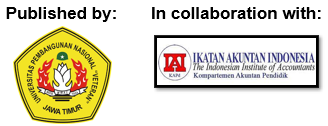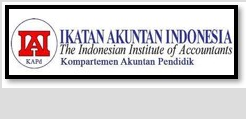Trading Volume Activity Surrounding Earnings Releases: Evidence from Indonesia
DOI:
https://doi.org/10.33005/jasf.v6i2.402Keywords:
Earnings announcement, efficient market hypothesis, market liquidity, trading volume activityAbstract
The study investigates trading volume activities post-earnings announcement and their impact on abnormal returns. The objectives are to examine the changes in trading volume activities in response to earnings release and to measure the impact of the changes in trading volume activities on the cumulative average abnormal returns post-earning announcement. The study analyzes the trading volume response around the earnings announcement by comparing the ratio of trading volume activity (TVA) post-earnings announcements with the TVA during the estimation window. It reports an apparent increase in trading volume activity on day +2, indicating a slightly delayed reaction to the event's information. However, the findings indicate a significant relationship between cumulative abnormal returns and trading volume during the post-earning announcement abnormal return in a short period, following the semi-strong form of market efficiency. The study focuses on year-end announcements and does not evaluate interim announcements. The market response to interim data may vary and requires validation through an additional investigation. This implies that market traders should implement an effective trading strategy before the entire market reacts to the earnings announcement. Furthermore, the research findings underscore opportunities for policymakers to improve market infrastructure, hence augmenting the market's efficacy in conveying information pertaining to earnings releases.
Downloads
References
Andrianto, Y., & Mirzab, A. R. (2016). A Testing of Efficient Markets Hypothesis in Indonesia Stock Market. Procedia-Social and Behavioral Sciences, 219, 99-103. https://doi.org/10.1016/j.sbspro.2016.04.048.
Angelo, B., & Johnston, M. (2023). Do investors infer future cash flow volatility based on liquidity? Review of Quantitative Finance and Accounting, 60(1), 259-294. http://dx.doi.org/10.1007/s11156-022-01094-4.
Ball, R., & Brown, P. (1968). An empirical evaluation of accounting income numbers. Journal of Accounting Research, 6(2), 159-178. https://doi.org/10.2307/2490232.
Banz, R. W. (1981). The relationship between return and market value of common stocks. Journal of Financial Economics, 9(1), 3-18. https://doi.org/10.1016/0304-405X(81)90018-0.
Bollen, J., Mao, H., & Zeng, X. (2011). Twitter Mood Predicts the Stock Market. Journal of Computational Science, 2(1), 1-8. https://doi.org/10.1016/j.jocs.2010.12.007.
Bonfim, D., Custódio, C., & Raposo, C. (2023). Supporting small firms through recessions and recoveries. Journal of Financial Economics, 147(3), 658–688. https://doi.org/10.1016/j.jfineco.2023.01.004
Brandao-Marques, L., Gelos, G., Ichiue, H., & Oura, H. (2022). Changes in the global investor base and the stability of portfolio flows to emerging markets. Journal of Banking & Finance, 144, 106615. https://doi.org/10.1016/j.jbankfin.2022.106615.
Busse, J. A., & Green, T. C. (2002). Market efficiency in real time. Journal of Financial Economics, 65(3), 415-437. https://doi.org/10.1016/S0304-405X(02)00148-4.
Chordia, T., Roll, R., & Subrahmanyam, A. (2001). Market Liquidity and Trading Activity. The Journal of Finance, 56(2), 501-530. https://www.jstor.org/stable/222572.
Davidson, R. H. (2022). Who did it matter: Executive equity compensation and financial reporting fraud. Journal of Accounting and Economics, 73(2-3), 101453. https://doi.org/10.1016/j.jacceco.2021.101453.
Demetriades, P., & Owusu-Agyei, S. (2022). Fraudulent financial reporting: an application of fraud diamond to Toshiba’s accounting scandal. Journal of Financial Crime, 29(2), 729-763. https://doi.org/10.1108/JFC-05-2021-0108.
Elizabeth, N. C., Nwezeaku, N. C., Mbadike, N. S., Chris-Ejiogu, U., & Ogoke, S. I. (2022). Financial Sector Development and Capital Formation: A Comparative Analysis of Nigeria and South Africa. In IIARD International Journal of Banking and Finance Research (Vol. 8, Issue 2, pp. 67–91). IIARD Publication Co. https://doi.org/10.56201/ijbfr.v8.no2.2022.pg67.91.
Fama, E. F. (1970), Efficient capital markets: A review of theory and empirical work, The Journal of Finance 25(2), 383–417. https://doi.org/10.2307/2325486.
Fangohoi, L., Yuniarti, S., & Respati, H. (2023). Analysis of the Effect of Return on Assets (ROA) and Current Ratio (CR), on Stock Prices with Earnings Per Share (EPS) as a Moderation Variable (On the Mining Sector on the IDX 2020- 2022). Journal of Economics, Finance and Management Studies, 06(09), 4285–4298. https://doi.org/10.47191/jefms/v6-i9-16.
Fink, J. (2021). A review of the post-earnings-announcement drift. Journal of Behavioral and Experimental Finance, 29, 100446. https://doi.org/10.1016/j.jbef.2020.100446.
Gaio, L. E., Stefanelli, N. O., Júnior, T. P., Bonacim, C. A. G., & Gatsios, R. C. (2022). The impact of the Russia-Ukraine conflict on market efficiency: Evidence for the developed stock market. Finance Research Letters, 50, 103302. https://doi.org/10.1016/j.frl.2022.103302.
Gârleanu, N. (2009). Portfolio Choice and Pricing in Illiquid Markets. Journal of Economic Theory, 144(2), 532-564. https://doi.org/10.1016/j.jet.2008.07.006.
Ginting J., Ginting, N. W., Putri, L., & Nidar, S. R. (2021). Optimal portfolio models for an inefficient Market. The Journal of Asian Finance, Economics and Business, 8(2), 57-64. https://doi.org/10.13106/jafeb.2021.vol8.no2.0057.
Hespeler, M. F., & Suntheim, F. (2020). The Behavior of Fixed-income Funds during COVID-19 Market Turmoil. International Monetary Fund. https://www.imf.org/en/Publications/global-financial-stability-notes/Issues/2021/03/16/The-Behavior-of-Fixed-income-Funds-during-COVID-19-Market-Turmoil-49951.
Hirshleifer, D., Lim, S., & Teoh, S. H (2011). Limited Investor Attention and Stock Market Misreactions to Accounting Information. Review of Asset Pricing Studies, 1 (1), 35-73. https://doi.org/10.1093/rapstu/rar002.
Holden, C. W., Jacobsen, S., & Subrahmanyam, A. (2014). The Empirical Analysis of Liquidity. Foundations and Trends in Finance, 8(4), 263-365. http://dx.doi.org/10.2139/ssrn.2402215.
Hunt, J. O., Myers, J. N., & Myers, L. A. (2022). Improving earnings predictions and abnormal returns with machine learning. Accounting Horizons, 36(1), 131-149. https://doi.org/10.2308/HORIZONS-19-125.
Ikram, F. & Nugroho, A. B. (2014). Cumulative Average Abnormal Return and Semi Strong Form Efficiency Testing in Indonesian Equity Market Over Restructuring Issue. International Journal of Management and Sustainability, 3(9), 552-566. https://archive.conscientiabeam.com/index.php/11/article/view/984.
Julyana, J., Njotoprajitno, R. S., & Hadianto, B. (2022). Market Responses Around the Publication Dates of Annual Financial Report. Economics and Business Quarterly Reviews, 5(1). https://ssrn.com/abstract=4015950.
Kim, O. & Verrecchia, R.E. (1994). Market Liquidity and Volume Around Earnings Announcements. Journal of Accounting and Economics, 17(1–2), 41–67. https://doi.org/10.1016/0165-4101(94)90004-3.
Kornlert, P., & Uachanachit, D. (2022). The factors influencing on information asymmetry estimate by total trading volume. Cuadernos de Economía, 45(128), 78-86. https://cude.es/submit-a-manuscript/index.php/CUDE/article/view/266.
Kumari, J. (2019). Investor sentiment and stock market liquidity: Evidence from an emerging economy. Journal of Behavioral and Experimental Finance, 23, 166-180.
Lee, A. X., & Hooy, C. W. (2023). Stock Liquidity and State Ownership: Evidence from the Banking Industry of Selected Asian Emerging Markets. Asian Journal of Business and Accounting, 1-30. http://dx.doi.org/10.22452/ajba.vol16no1.1.
Lev, B., & Gu, F. (2016). The End of Accounting and the Path Forward for Investors and Managers. Hoboken, NJ: John Wiley & Sons.
Mirali, M., Gholami Moghaddam, F., & Hesarzadeh, R. (2018). Investigation of the relationship between financial reporting tone with future corporate performance and market return. Financial Accounting Knowledge, 5(3), 81-98. https://doi.org/10.30479/jfak.2018.1513.
Modigliani, F., & Miller, M. H. (1958). The cost of capital, corporation finance, and the theory of investment. The American Economic Review, 48(3), 261-297. https://www.jstor.org/stable/1809766.
Mupondo, N. C. (2022). Liquidity, trading activity, and stock price volatility: Evidence from a stressed market. Finance & Economics Review, 4(2), 12-25. https://doi.org/10.38157/fer.v4i2.482.
Naik, P., & Reddy, Y. V. (2021). Stock Market Liquidity: A Literature Review. Sage Open, 11(1), 1–15. https://doi.org/10.1177/2158244020985529.
Ngene, G. M., & Mungai, A. N. (2022). Stock returns, trading volume, and volatility: The case of African stock markets. International Review of Financial Analysis, 82, 102176. https://doi.org/10.1016/j.irfa.2022.102176.
Novi, S. B., & Pontoh, W. (2022). Market efficiency and global issues: A case of Indonesia. Investment Management & Financial Innovations, 19(4), 1. http://dx.doi.org/10.21511/imfi.19(4).2022.01.
Odhiambo, A., Koske, N., & Limo, P. (2022). Debt-Equity Ratio, CEO Power and Financial Performance of Listed Companies at the Nairobi Securities Exchange, Kenya. European Journal of Business and Management Research, 7(2), 330–338. https://doi.org/10.24018/ejbmr.2022.7.2.1391.
Patra, S., & Hiremath, G. S. (2022). An entropy approach to measure the dynamic stock market efficiency. Journal of Quantitative Economics, 20(2), 337-377. https://doi.org/10.1007/s40953-022-00295-x.
Plerou, V., Gopikrishnan, P., Gabaix, X., Amaral, L. A. N., & Stanley, H. E. (2001). Price Fluctuations, Market Activity, and Trading Volume. Quantitative Finance, 1(2), 262-269. https://doi.org/10.1088/1469-7688/1/2/308.
Rinata, O., & Suryaningrum, D. (2023). Pengaruh Kepemilikan Publik dan Waran Saham terhadap Kinerja Pasar IPO di Bursa Efek Indonesia. Jurnal Ilmiah Manajemen, Ekonomi, & Akuntansi (MEA), 7(3), 1813-1841. https://doi.org/10.31955/mea.v7i3.3579
Rowter, K. (2016). Indonesian capital market developments and challenges. Nomura Journal of Asian Financial Markets, 1(1), 9-13. https://www.nomurafoundation.or.jp/en/wordpress/wp-content/uploads/2016/10/NJACM1-1AU16-05_Indonesia.pdf.
Sari, P., & Supratiwi, W. (2019). Factors Affecting Investment Opportunity Set: A Study of Company Advantages and Limitations. Sustainable Business Accounting and Management Review, 1(1), 1–8. https://doi.org/10.61656/sbamr.v1i1.23.
Sehgal, S. & Bijoy, K. (2015). Stock Price Reactions to Earnings Announcements: Evidence from India. Vision, 19, 25-36. https://doi.org/10.1177/ 0972262914564042.
Sun, P. W., & Wen, Z. (2023). Stock return predictability of the cumulative abnormal returns around the earnings announcement date: Evidence from China. International Review of Finance, 23(1), 58-86. https://doi.org/10.1111/irfi.12380.
Vasileiou, E. (2022). Behavioral finance and market efficiency in the time of the COVID-19 pandemic: does fear drive the market? In The Political Economy of Covid-19 (pp. 116-133). Routledge. https://doi.org/10.1080/02692171.2020.1864301.
Wright, C., & Swidler, S. (2023). Abnormal trading volume, news and market efficiency: Evidence from the Jamaica Stock Exchange. Research in International Business and Finance, 64, 101804. https://doi.org/10.1016/j.ribaf.2022.101804
Quah, H., Haman, J., & Naidu, D. (2021). The effect of stock liquidity on investment efficiency under financing constraints and asymmetric information: Evidence from the United States. Accounting & Finance, 61, 2109-2150. https://doi.org/10.1111/acfi.12656.
Zhang, S., & Gregoriou, A. (2020). Post earnings announcement drift, liquidity and zero leverage firms: Evidence from the UK stock market. Journal of Business Research, 116, 13-26. https://doi.org/10.1016/j.jbusres.2020.05.005.
Zhang, Y., Zhang, Y., & Yao, T. (2022). Fraudulent financial reporting in China: Evidence from corporate renaming. Journal of Contemporary Accounting & Economics, 18(1), 100283. https://doi.org/10.1016/j.jcae.2021.100283.














